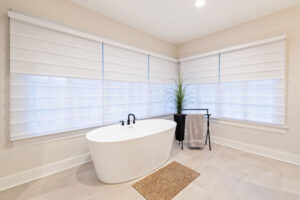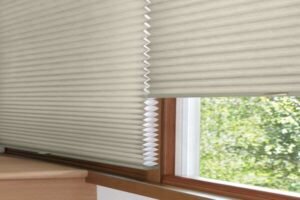Attempts to convert existing blinds into motorized blinds often result in poor performance. Most standard blinds are not designed for motor systems, and retrofitting can cause misalignment, jerky movement, or damage. Motors must be properly matched to the blinds’ design to function correctly.
Blinds with built-in motorization are engineered for smooth, reliable use. Their components are designed to work together without the complications that come from retrofitting. For long-term performance, it’s better to choose window treatments made for motorization from the start.
How Motors and Shades Work Together
Manufacturers design blinds and motors together to ensure seamless functionality. Each motor is specifically engineered to match the mechanics of its corresponding blinds, including the exact start and stop points. For instance, shades typically have programmed upper and lower limits, and the motor must align precisely with these points for smooth operation.
If you install an aftermarket motor not designed for your blinds, the motor won’t know where the blinds should stop. This can cause the blinds to overshoot their intended positions, leading to operational issues and potential damage.
Misconceptions About Converting Existing Blinds
Many homeowners assume they can swap out a manual mechanism for a motor, similar to changing a battery in a device. Unfortunately, this isn’t how window treatments work. There is no universal motor that can be inserted into existing blinds without complications. Here are some common misconceptions:
- “A Motor Can Just Be Inserted Later”: Blinds are not designed for plug-and-play motor installations. Manufacturers build motors into the design from the start, ensuring perfect alignment and compatibility.
- “Cartridge Motors Can Be Added”: Some believe that cartridge-style motors can be inserted into existing blinds. However, this approach does not account for the shade’s weight, material, and movement requirements, which can cause performance issues.
- “Any Motor Will Work”: Not all motors are equal. Motors must be tailored to the specific shade design; otherwise, performance and durability will suffer.
Potential Issues with Aftermarket Motors
There are products available on the market, including some from crowdfunding platforms like Kickstarter, that claim to convert existing blinds into motorized versions. However, these solutions often come with significant drawbacks:
- Incompatibility: Motors designed independently of the shade manufacturer often don’t sync correctly with the blind’s mechanical components.
- Warranty Voidance: Installing an aftermarket motor may void the manufacturer’s warranty on the blinds. If a malfunction occurs, you’ll be responsible for the repair or replacement costs.
- Long-Term Damage: Improperly installed motors can damage the internal structure of the blinds and lead to irreversible wear and tear
- Performance Issues: Aftermarket motors often struggle to control the blinds smoothly, which results in jerky movements, misaligned stops, and operational issues.
The Importance of Purchasing Blinds with Built-In Motors
The best way to enjoy the benefits of motorized blinds without the associated risks is to purchase blinds with built-in motorized systems from the outset. Manufacturers like Hunter Douglas, with whom we proudly partner, engineer their motors and blinds together for maximum efficiency and reliability.
Here are some benefits of purchasing blinds designed with motorization from the start:
- Optimal Performance: Motors and blinds are engineered as a single unit to ensure smooth and consistent operation.
- Warranty Protection: Products come with manufacturer-backed warranties, protecting your investment for years to come.
- Long-Term Cost Savings: While buying motorized blinds initially might seem more expensive, it can prevent costly repairs or replacements later.
- Advanced Features: Factory-installed motors often come with advanced features such as app control, voice activation, and programmable settings.
Why Retrofitting Isn’t Cost-Effective
While some homeowners consider retrofitting their existing blinds to save money, the costs and complications often outweigh the benefits. Retrofitting can lead to frequent malfunctions, performance issues, and eventually, the need to replace the entire window treatment.
In contrast, investing in motorized blinds from the start ensures you get a reliable, warranty-protected product that will function as intended for years to come.
In Summary
Are you wondering if you can convert existing blinds into motorized blinds? While it might seem like a convenient upgrade, the process is often more complex than it appears. Aftermarket motors rarely work seamlessly with existing blinds, leading to performance issues, voided warranties, and potential damage. The best solution is to invest in blinds with factory-installed motorization for reliable, long-term performance.
If you’re considering converting existing blinds to motorized ones, contact us today. We’re happy to help you find the perfect, reliable window treatments to fit your needs.













